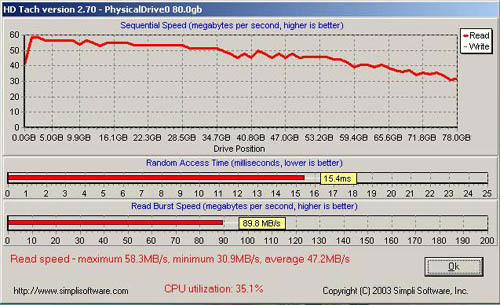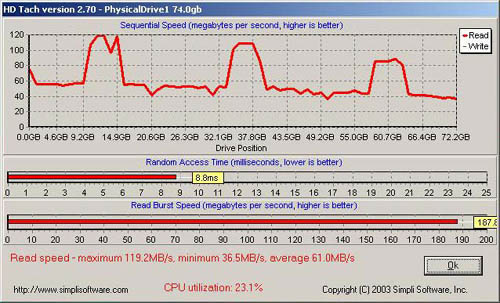nForce3-250 - Part 2: Taking Athlon 64 to the Next Level
by Wesley Fink on March 29, 2004 11:00 AM EST- Posted in
- CPUs
nForce3-250Gb: IDE and RAID Benchmarks
Disk Performance Testing can provide extremely variable results, even when test conditions are well-controlled. For that reason, we were skeptical to drop IDE and RAID tests into our review of the nForce3-250Gb. However, it was certain, given nVidia's past lackluster drive performance, that HD tests should be included in nF3-250 benchmarking.Some of the most commonly used benchmarks for Hard Drive Testing are HDtach 2.7, PCMark 2004 HD Tests and SiSoft Sandra 2004 File System Benchmark. We have included all 3 test results here for both IDE and nVidia RAID. Tests in both cases were run on Hard Drives about 20% full, with the benchmark run from the IDE hard drive. The IDE hard drive was a 7200 RPM 80GB drive with a 50GB C: boot partition, and tests were run on C:. The RAID array was 2 Western Digital Raptor 10,000 RPM 36.7GB hard drives. Both the IDE and RAID were driven by nVidia IDE drivers in nForce Platform Driver 4.04.
Sandra 2004 shows a 38% increase in throughput with nVidia 10,000RPM RAID compared to a single 10,000RPM SATA drive. PCMark 2004 HDD Test Suite shows a smaller increase in performance with RAID, around 27%. Benchmarks for a single 7200RPM IDE are also included for comparison.
Perhaps even more important for critics of past nVidia IDE implementations is that nVidia and Intel throughput in IDE is now about the same with the nForce3-250Gb. Intel SATA RAID is a bit faster in Sandra, but the difference in measured benchmark performance was very small, at about 6%.
For those who hate the numbers from benchmarks like Sandra and PCMark, the HDTach screen captures provide a very interesting snapshot. The two graphs below, with blue title bars, represent nVidia's nForce3-250Gb drive controller performance.


We also tested the Intel RAID controller with another pair of 10,000 rpm Western Digital Raptors. Those results are shown with the green title bar below.

As you can see, performance of the Intel SATA RAID and nVidia SATA RAID are virtually identical.
The biggest surprise in the HD Tach benchmarks was the fact that SATA RAID requires half the overhead of basic IDE in nVidia's implementation. However, the CPU utilization, while greatly improved over numbers we have seen for nVidia in the past, is still very high compared to Intel's SATA RAID. Part of this has to do with the architectural differences between Athlon 64 and Intel processors and chipsets, but there is still a large difference in CPU overhead between the nVidia and Intel RAID solutions. Frankly, the real performance difference is likely to be nil on the typical desktop, but this will matter to some.










46 Comments
View All Comments
Odeen - Monday, March 29, 2004 - link
Quote:"the best audio Intel offered (on-board) at the time was the crappy Realtek Codec"
Wrong.
Intel offered a software audio solution. I.E. the chipset basically offloaded audio calculations to the CPU. Thus, the 3d audio rendering was crappy, true.
However, Realtek is not the only manufacturer of codec chips, just the cheapest. Boards from Intel and Asus have very nice ADI Soundmax chips with pretty good audio output quality.
On the other hand, Soundstorm offers high quality 3d audio rendering, but it is _ALWAYS_ paired with that SAME crappy Realtek ALC650 chip, which offers lousy analog output quality. I'd personally love to see Soundstorm coupled with a higher-end analog stage, such as a Sigmatel codec chip on an outboard card (ACR form factor, for instance).
And RAID-5 will be in-chipset when chipsets become as powerful as CPU's and average consumers will be taught to buy three or more drives. That is, never - RAID-5 is not for benchmarkers, and anyone with a "Type R" sticker, it's slower than RAID-0, but is obviouly far more secure, and wastes less disk than RAID1. It's a specialized feature for people who realize its value and want to spend the money to implement it.. it'd raise the chipset price by quite a bit, and is thus better off to left to an add-on card.
The other thing is, due to sensitive nature of RAID-5 (i.e. it's harder to implement than a software RAID-0 or RAID-1 that cheap PCI add-on cards and southbridges now offer) people who have the money to spend on RAID-5 will want a solution from people they trust, i.e. Adaptec or the likes.. They wouldn't accept trusting their precious data to a company that makes their son's gee-whiz video card :)
mkruer - Monday, March 29, 2004 - link
I want to know when we are going to see RAID-5 in a chipset, for average consumers.Sahrin - Monday, March 29, 2004 - link
<i>Customer surveys by nVidia found that most buyers did not use Sound Storm</i>I just can't believe that. I remember Soundstorm being a *huge* selling point for all kinds of people. When it came down to Intel v. AMD (especially when there were only "b" rev chips) Soundstorm was often the deciding factor; the best audio Intel offered (on-board) at the time was the crappy Realtek Codec. A lot of people made decisions to go with AXP-nForce 2 MCP-T boards over a comparable Intel package because of Soundstorm. (I know the Enthusiast market is still just a tiny sliver of sales, even for a chipset company like nVidia but I can't be convinced that this wasn't because Soundstorm is as good or better than products from Creative and/or M-Audio).
Cygni - Monday, March 29, 2004 - link
^^ btw, there are only 3 boards offered with the 755 on newegg... ECS 755 A1 and A2, and the ASrock k8s8x.Cygni - Monday, March 29, 2004 - link
Looks better than the 150... but SiS is really kickin a$$. I wish the market would embrace the 755 more so we could see a better range of solutions based on it.wicktron - Monday, March 29, 2004 - link
any clue as to when production boards will hit the market?